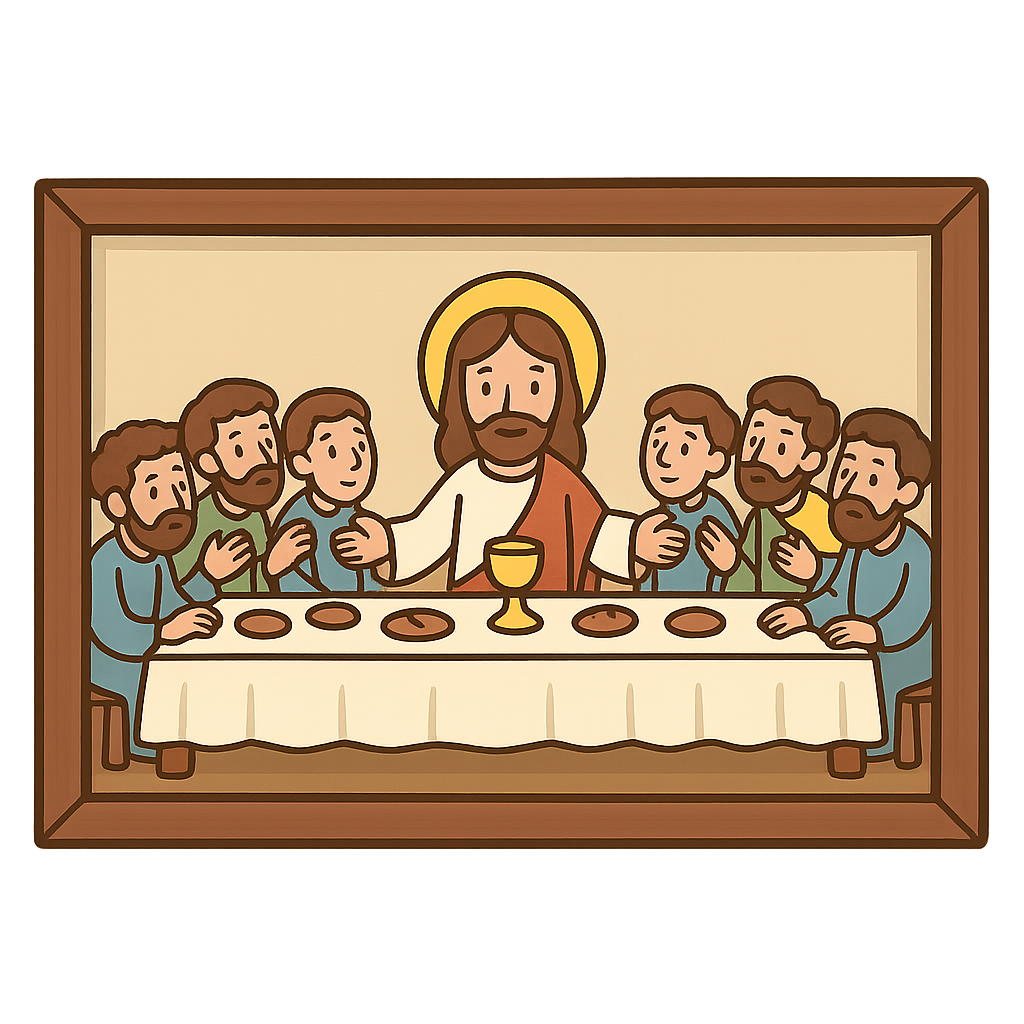A Story on a Wall
For more than five hundred years, I have lived on a wall in a long, peaceful room in Milan, Italy. Long wooden tables stretch out before me, and for centuries, I have watched people gather here for their quiet meals inside a convent. But I am not just a decorated wall. I hold a secret, a story painted right onto my plaster skin with colors and light. It’s a story about one very important dinner, a moment frozen in time that is full of feeling. If you look closely at me, you’ll see a man with a kind, calm face at the center of the long table. He is surrounded by his twelve closest friends, his apostles. But something shocking has just been said. Their hands fly up in the air, their faces are filled with confusion and surprise, and they lean toward one another, whispering and asking questions. One man clutches a small bag of coins and leans back, his face hidden in the shadows. I am a mural, a very special kind of painting made directly on the wall. My name is The Last Supper.
My maker was a true genius, a man named Leonardo da Vinci. He wasn't just a painter who could create beautiful art. Oh no. He was an inventor who dreamed of flying machines, a scientist who studied how water flows and how the human body works, and a musician who could play beautiful tunes. His mind was like a sky full of shooting stars, always bursting with brilliant new ideas. Around the year 1495, a powerful ruler, the Duke of Milan, Ludovico Sforza, asked Leonardo to paint a special scene for this very dining hall. Leonardo didn’t want to create just any painting. He wanted to capture a single moment that was filled with real, powerful feelings. Most painters at the time would paint on wet plaster, a technique called fresco, which had to be done very quickly. But Leonardo wanted to take his time to get every single expression just right. So he tried something new and risky. From 1495 until 1498, he painted on my wall after it was already dry. This allowed him to work slowly, adding details and changing his mind, just like you might erase a drawing to make it perfect. Sometimes he would stand and stare at me for a whole day before adding a single brushstroke. The story he wanted to tell was the exact instant Jesus tells his apostles that one of them will betray him before the next morning. Can you imagine the gasp that must have filled the room? I show you that gasp. Look at Peter, grabbing a knife in anger. See John, so sad he looks like he might faint. And there is Judas, the one who will betray Jesus, pulling away from the light. Leonardo didn't just paint thirteen men eating dinner. He painted a storm of human emotions—surprise, fear, anger, and deep sadness—all in one picture.
Leonardo’s brilliant idea for painting on a dry wall had a sad secret. My colors weren’t sealed into the plaster the way they are in a fresco. As the years turned into centuries, the paint began to flake and crumble away. Bits of my story started to disappear, like a whisper fading in the wind. The steam from the kitchen and the dust of ages made my colors grow dim. I have survived so much more than just time. A door was once cut right through my bottom, where Jesus’s feet would have been. And on August 15th, 1943, during a terrible war, a bomb fell and destroyed the roof and other walls of my room. But the wall I live on, protected by sandbags, miraculously stood strong. For many years, patient people called restorers have worked to save me. Using tiny brushes and special scientific tools, they have cleaned away the grime and carefully tried to preserve what is left of my flaking paint. It’s like a doctor helping a very old patient feel a little bit better. Even though I am fragile and parts of me are lost forever, people from every corner of the world still travel to Milan to sit in this quiet room and look at me. I show them that a single moment in time can hold a whole world of feelings, and I hope I inspire them to see that every person's face tells a story worth understanding.
Reading Comprehension Questions
Click to see answer
